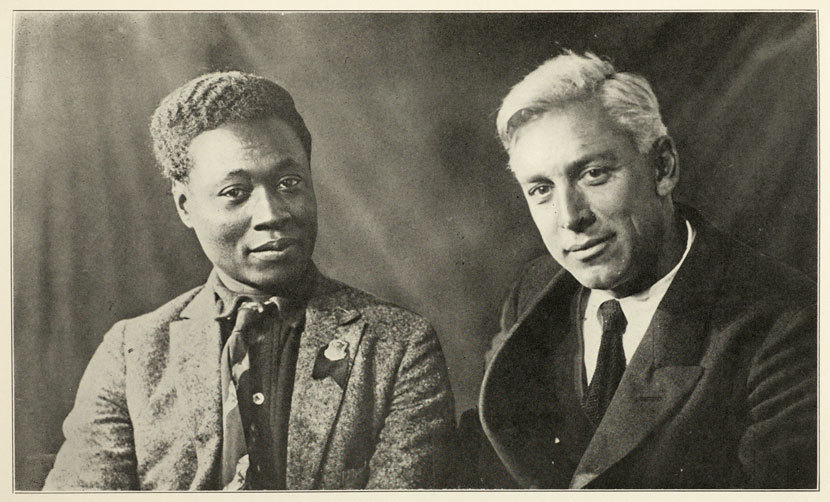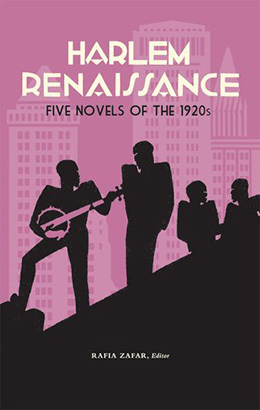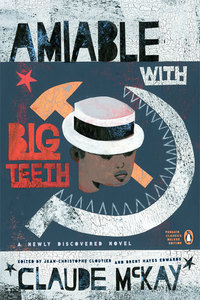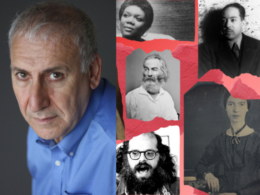Our guest post today comes from Christoph Irmscher, professor of English at Indiana University, Bloomington, editor of the Library of America volume John James Audubon: Writings and Drawings, and author of the recently published Max Eastman: A Life (Yale University Press, 2017), a biography of the twentieth–century activist, poet, and public intellectual who edited the influential leftist “little magazines” The Masses and The Liberator. Here, Irmscher focuses on Eastman’s relationship with the writer Claude McKay, whose classic 1928 novel Home to Harlem is included in the Library of America collection Harlem Renaissance: Five Novels of the 1920s.
By Christoph Irmscher
The publication earlier this year of a newly discovered novel by the Jamaican-born writer Claude McKay (1889-1948) was met with elation. The somewhat baroquely titled manuscript, Amiable with Big Teeth: A Novel of the Love Affair between the Communists and the Poor Black Sheep of Harlem, was authenticated with the help of a letter by McKay’s friend, the writer and activist Max Eastman (1883-1969). In their introduction to Big Teeth, editors Jean-Christophe Cloutier and Brent Hayes Edwards wonder why McKay gave up on the novel and claim that the “archival trail” ends with a letter to Eastman dated July 28, 1941, in which McKay announced that he had just submitted his manuscript (which initially bore the title God’s Black Sheep) to John Macrae, the president of E.P. Dutton. Recently acquired material in the Max Eastman papers at Indiana University’s Lilly Library and included in my new biography of Eastman now allows us to tell the full story.

A flamboyant, colorful figure, Max Eastman for decades dominated the radical political scene in the United States. Throughout his life, the sociable Eastman, once a passionate campaigner for women’s suffrage, preferred the company of women. The one exception: the dapper, smooth-faced McKay, whose intelligence and integrity impressed him. McKay, for his part, loved Eastman. One of the most memorable episodes in their friendship, not told in the biographies but narrated in detail in a letter Eastman wrote to his lover Florence Deshon, involved an automobile accident. In August 1919, the car-crazy Eastman was shuttling his friends around uptown New York in his Ford Model T. In Harlem, he stopped to pick up McKay. Eastman was speeding down 153rd Street when a boy suddenly ran into the path of his car. Knowing that he wouldn’t be able to brake in time, Eastman deliberately rammed his beloved Ford into a tree, thus likely saving the boy’s life. The car was wrecked. When dragging the boy to where he said he lived, Eastman found an apartment awash with kids. No one had missed the boy, and no one seemed upset by what had nearly happened to him. McKay was entranced by Eastman’s courage and nonchalant nobility, one not measured by conventional parameters of success. Eastman’s risk-taking, seemingly independent of social conventions, fascinated him: “I love your life!” (to Eastman, July 28, 1919).
Eastman returned the affection and made McKay an associate editor of The Liberator. McKay thanked him by pointing out that the magazine, edited mostly by whites, hadn’t given blacks the prominent role that they deserved given how central they were to the class struggle in America. He charged that Eastman knew little about what it meant to be black in America. By now their roles were reversed: throwing his lot in with the Bolsheviks and living in Moscow for several months in 1922–23, McKay had become the risk-taker and Eastman the watcher from the sidelines. But when Eastman traveled to Russia, he was delighted to see his old friend again, “the prince of the revolution,” looking luminous like a “black pearl” among all the somber Bolsheviks (note in Eastman’s journal, “In Russia,” 1922–23).
| Read Home to Harlem in |
 |
| Harlem Renaissance Novels: Five Novels of the 1920s |
Their friendship weathered disagreements. From Morocco, where McKay had moved later in the ’20s and where poverty constantly interfered with his attempts to write, he pelted Eastman with desperate calls for help. When he decided to return to the States, his friend helped him obtain a visa. (The American consul in Morocco laughingly observed that the ex-communist Eastman really wasn’t the best character reference McKay could have gotten.) The years after McKay’s return were overshadowed by continuing financial woes, recurring health problems, and his growing disenchantment with communism. Eastman, who had also moved rightward, stood by him, lending moral support and practical help. And that is precisely what he did when, in February 1941, publisher John Macrae asked Eastman to supervise McKay as he was finishing God’s Black Sheep. Macrae had seen McKay’s outline and thought it was too “melodramatic” and lacking in “artistic taste and refinement” (to Eastman, February 12, 1941).
Initially, the arrangement seems to have worked. McKay told Eastman on March 29 that he had made the novel more political, turning it into an extended commentary on African-American internationalism in the 1930s and specifically on the efforts of jealous white communists to undermine black attempts to support Ethiopia. Eastman liked the first fifty pages of the novel and told McKay on April 20 that his book had the potential to become “the great (Afro) American novel” everyone was waiting for. His advice: Slow down, Claude. Work on your prose; relish your power, honed in poetry, to create memorable, vivid images. But McKay, haunted by money problems, didn’t slow down. On July 24, he dispatched a full version of his manuscript to Macrae.
Things didn’t go well. In a newly discovered letter to Eastman dated August 6, McKay told him what happened. Anxious to hear what Macrae thought, McKay had called him and heard the stunning news that Dutton’s “Editorial Department” had rejected the novel. What concerns they had, whether about “structural form or subject matter,” he couldn’t find out. Eastman wasn’t at fault, he told Macrae. But in reality McKay did blame his friend, reminding Eastman that when he had sent him that first batch, Eastman had kept him waiting for so long that, “stung by anxiety,” he couldn’t work at all—and that when he was racing against time.
On August 7, Macrae put his rejection in writing. His harshly worded letter ended up in the file cabinet at Eastman’s Vineyard home, where it sat until recently, when I retrieved it along with reams of other correspondence. A weird typo aside, Macrae’s letter at first sounds fairly professional: “I have given very careful consideration to your manuscript, GOD’S BLACK SHEEP, and I am decling [sic] it and returning it to you at your address at 33 West 125th Street.” But he then went on, stiffly, to remind McKay of their original contract: “It was agreed between us at the time we undertook to pay you certain advances that you would keep in full harmony and in direct contact with Mr. Max Eastman so that you would have his valuable advice in the writing of your proposed novel.” By not relying on Eastman throughout, McKay had, for reasons of his own, broken their contract. Macrae’s conclusion was devastating: “I regret GOD’s BLACK SHEEP is so bad and so poor that I cannot offer you any hope of its being revised in a satisfactory way to meet what I believe a novel by you must be.” Note the lethal irony implicit in this verdict: not only had McKay failed to satisfy his publisher, he had betrayed his own standards.

Then Macrae became technical, the publisher masking as penny-pinching accountant. McKay had been promised an advance of $350, which was paid to him in installments, along with an additional $125 that he had also requested. Then, on July 24, the manuscript came, and it was “so poor that I refrained from paying you the last $25.” Nevertheless, Macrae threatened to hold McKay accountable for the full amount of $475 (about $7,500 today) “if you sell the manuscript to another publisher or receive any monies from any source whatsoever in connection with the publication of the manuscript.” None too subtly, Macrae was reminding the destitute McKay that, even though he didn’t want his novel, no one else should get to publish it either. Earlier the same year, Macrae had used much more cordial language when turning down W. E. B. Du Bois’s collection of plays, The Sorcery of Color: “Your work has decided possibilities . . . I am very sorry to have come to this decision.” Unlike Du Bois, McKay wasn’t a gentleman: “I took your outline for this book in good faith with your promise that we need not pay any attention to the outline, and that the manuscript when completed and sent in would carry the approval of Max Eastman and would be a manuscript worthy of you as a writer and worthy to be published by E.P. Dutton & Co., Inc.”
When, in his final paragraph, Macrae dismisses God’s Black Sheep for the third time, just to turn the knife a little, one suspects personal disappointment rather than editorial expediency. He wished McKay well, he hastened to add. But, really, God’s Black Sheep was “so poor that you cannot improve it.” Macrae signed his letter “regretting that conditions are as they are,” as if the rejection were a random blow of fate visited from above rather than a decision made by him.
McKay’s vexed reply, carbon-copied to Eastman, came on August 8. He was “chagrined and depressed,” he said. Never had there been any “inharmony” between Eastman and him. “I was always writing to him.” But hampered by distance (he was in Maine and Eastman was in Florida) and a polite reluctance to bother his “unselfish” friend, he had taken the latter’s positive reaction to the first few chapters as a signal “to go straight ahead with the rest of the story according to my own plan.” Writing novels, for him, was a job as well as a literary undertaking.
Then McKay came to the point: “I have no idea what, in the opinion of your readers, is the worse [sic] thing about the manuscript, whether it is the actual writing, the conception or subject matter of the story or all combined that makes it bad.” Yes, he had taken a risk by writing “a contemporary historical tale of local conflict with an ethical basis”—essentially a novel of ideas and not a character-based book like McKay’s earlier novel Home to Harlem (1928). But he had also introduced humorous elements to enliven his rather somber “pot” (as he hilariously misspells plot). So what was the problem?
This is a remarkable letter, both apologetic and defiant. It is the latter quality that I suppose appalled Macrae when he read God’s Black Sheep. To be sure, McKay’s long–forgotten manuscript is not the Great African American Novel Eastman had hoped it would be. What’s best about it, however, no matter how much McKay might have rushed to finish it, is precisely the quality Eastman recognized and encouraged: the vivid, visceral, and sometimes brutal imagery, a perfect vehicle for the rawness of the emotions McKay’s characters experience. It reaches its peak at the end of the novel when Maxim, the white villain, dies a gruesome, ritualistic death at the hands of a group of masked leopard men, black avengers of his deceitful acts. As they drive their claws through him before he falls and breaks his “vile body” on the pavement, “Tasan was shot through with excruciating pain as if a shower of poisoned darts had penetrated his vitals.” I bet that wasn’t the “refinement” Macrae was expecting. But McKay, “battered and ready for the scrap heap,” as he summarized his condition in another letter to Eastman (November 26, 1943), could no longer afford daintiness. When he died a few years later, Eliena Eastman observed, coldly but not inaccurately, that McKay had “stopped living years ago.” Max Eastman, however, was heartbroken: “Poor Claude!” (to Eliena Eastman, May 24, 1948).
Note: John Macrae’s letter to Claude McKay, August 8, 1941; Claude McKay’s letter to John Macrae, August 8, 1941; and Claude McKay’s letters to Max Eastman, August 6, 1941 and November 26, 1943, are part of the Max Eastman Mss. II, Addition 1, The Lilly Library, Indiana University Bloomington. All other letters cited appear in Claude McKay, Amiable with Big Teeth, ed. Jean-Christophe Cloutier and Brent Hayes Edwards (Penguin, 2017) and my new biography, Max Eastman: A Life (Yale, 2017). Macrae’s letter to Du Bois is in the W. E. B. Du Bois Papers, University of Massachusetts Amherst.



